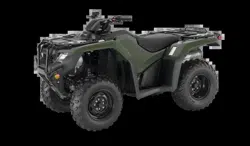Documents: Go to download!
- User Manual - (English)
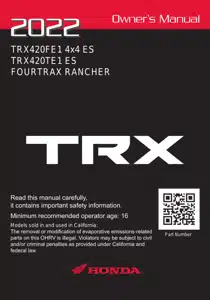
- Operation Component Locations
- Indicators & Displays
- Accessories & Modifications
- Starting & Stopping the Engine
- Taking Care of the Unexpected
Table of contents
Owner Manual Scooter
Operation Component Locations
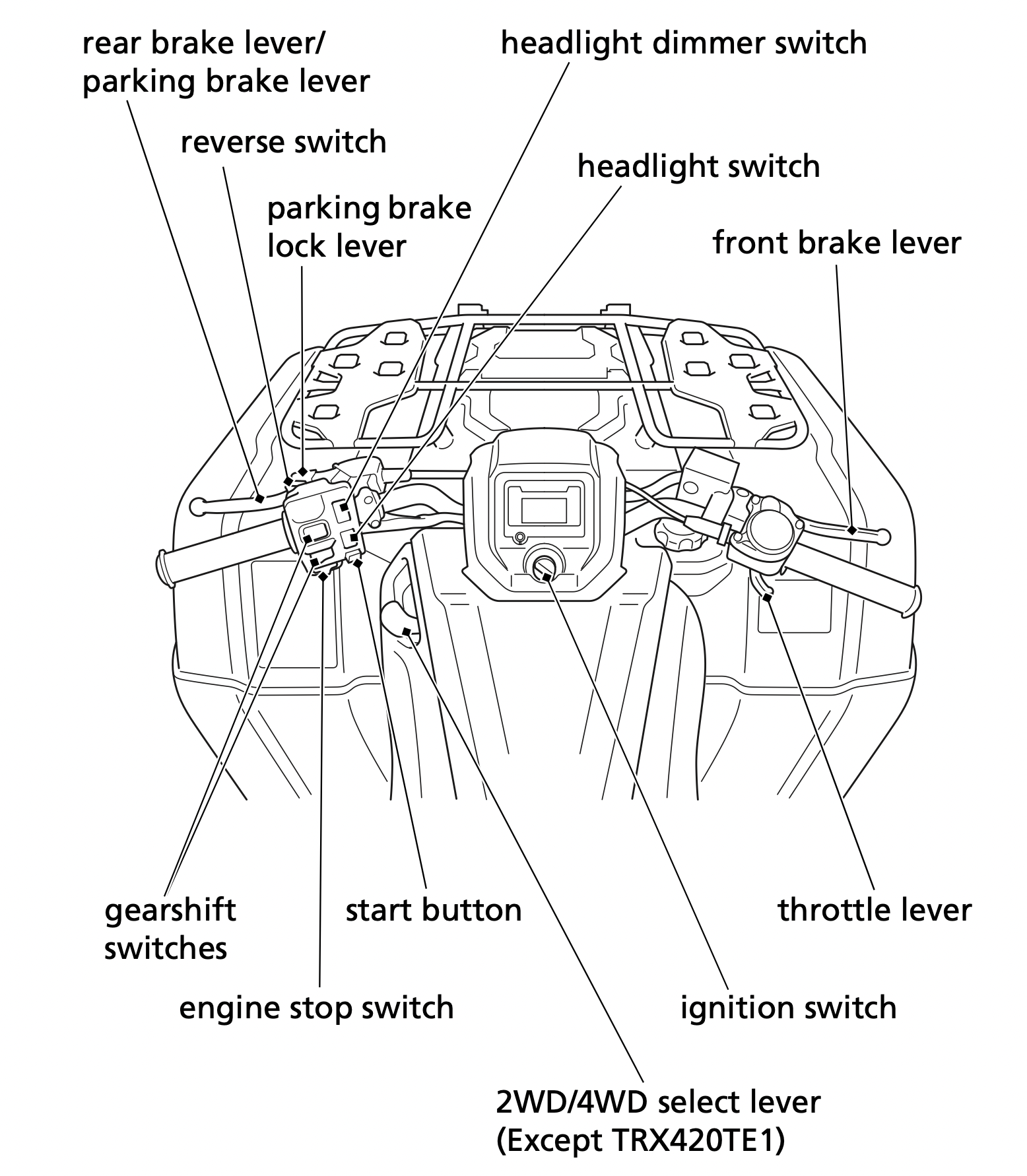
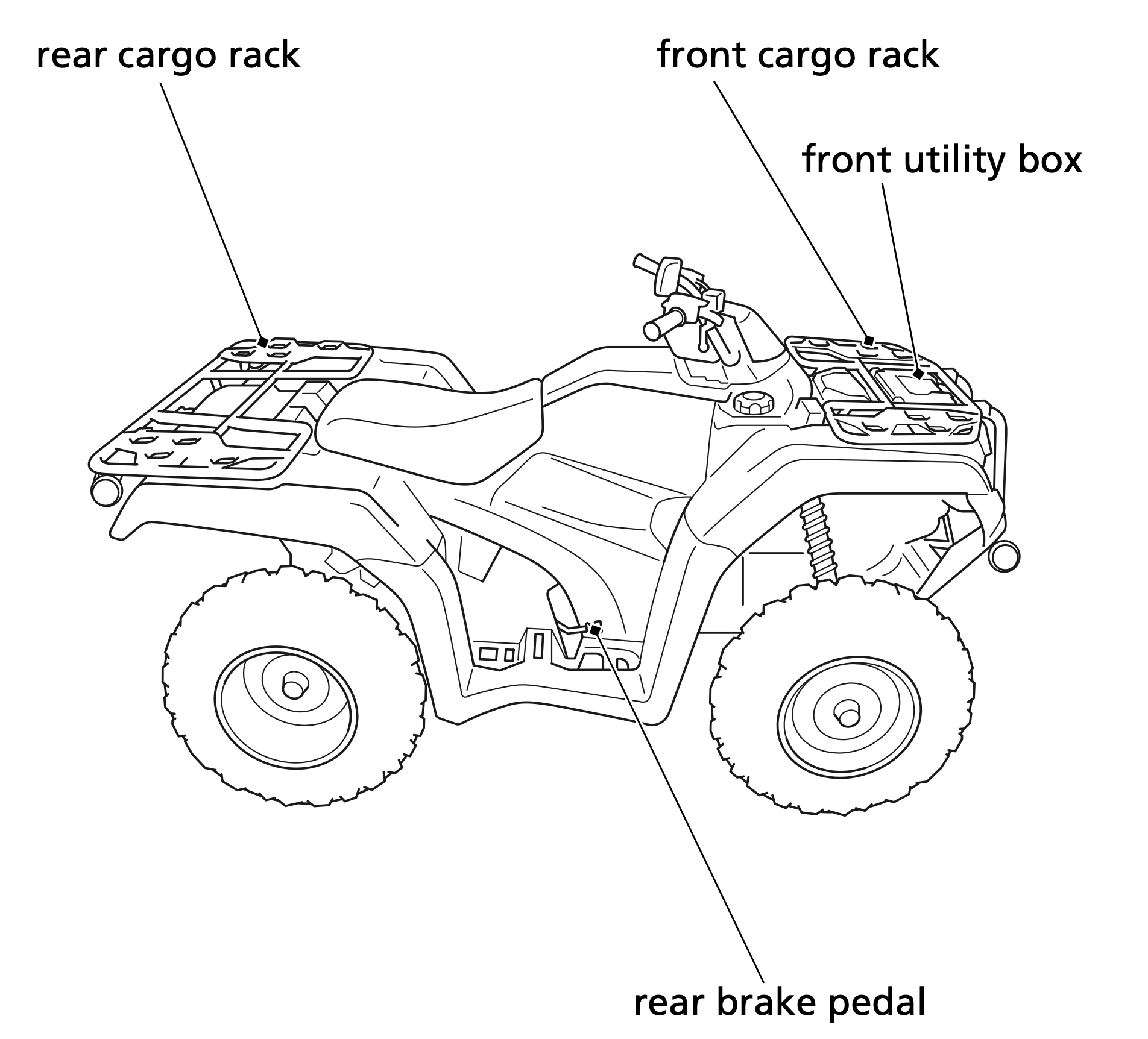
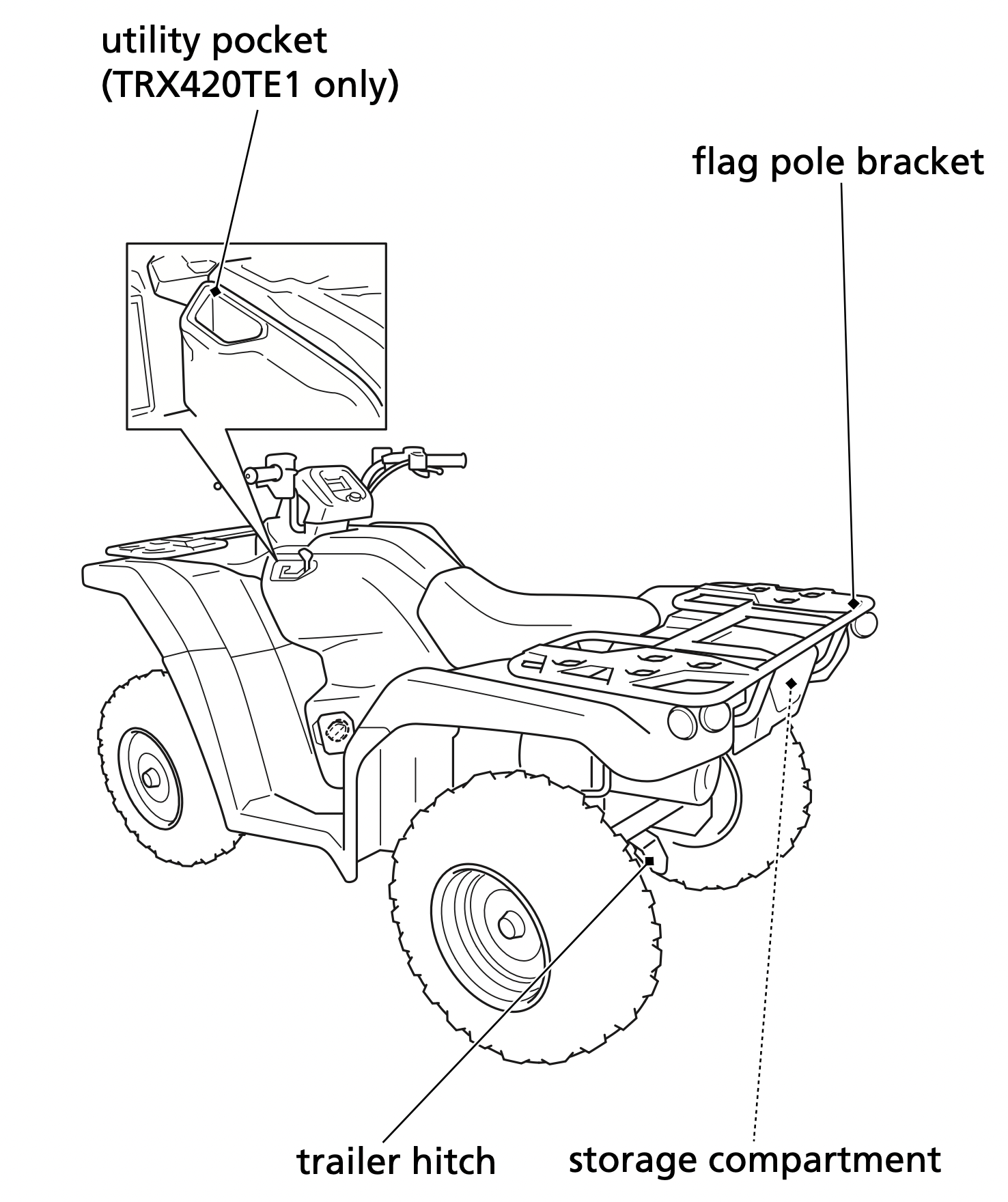
Indicators & Displays
The indicators and displays on your ATV keep you informed, alert you to possible problems, and make your riding safer and more enjoyable. Refer to the indicators frequently. Their functions are described on the following pages.

- neutral indicator
- reverse indicator
- PGM-FI indicator
- high coolant temperature indicator
- multi-function display
- mode button
Lamp Check
Initial lamp check:
The indicators come on for a few seconds and then go off when you turn the ignition switch to ON ( I ).
The high coolant temperature indicator and PGM-FI indicator will temporarily come back on for a few seconds and then go off after initial lamp check.
These indicators are identified in the table on page 17 with the words: Lamp Check.
When applicable, the reverse or neutral indicators come back on and remain on until you shift out of reverse or neutral after initial lamp check.
If one of these indicators does not come on when it should, have your dealer check for problems.
Display Check
When the ignition switch is turned on, the multi-function display (1) will temporarily show all the modes and digital segments and initial message. So you can make sure the liquid crystal display is functioning properly.
The displays are identified in the table on page 18 with the words: Display Check.
If any part of these displays does not come on when it should, have your dealer check for problems.



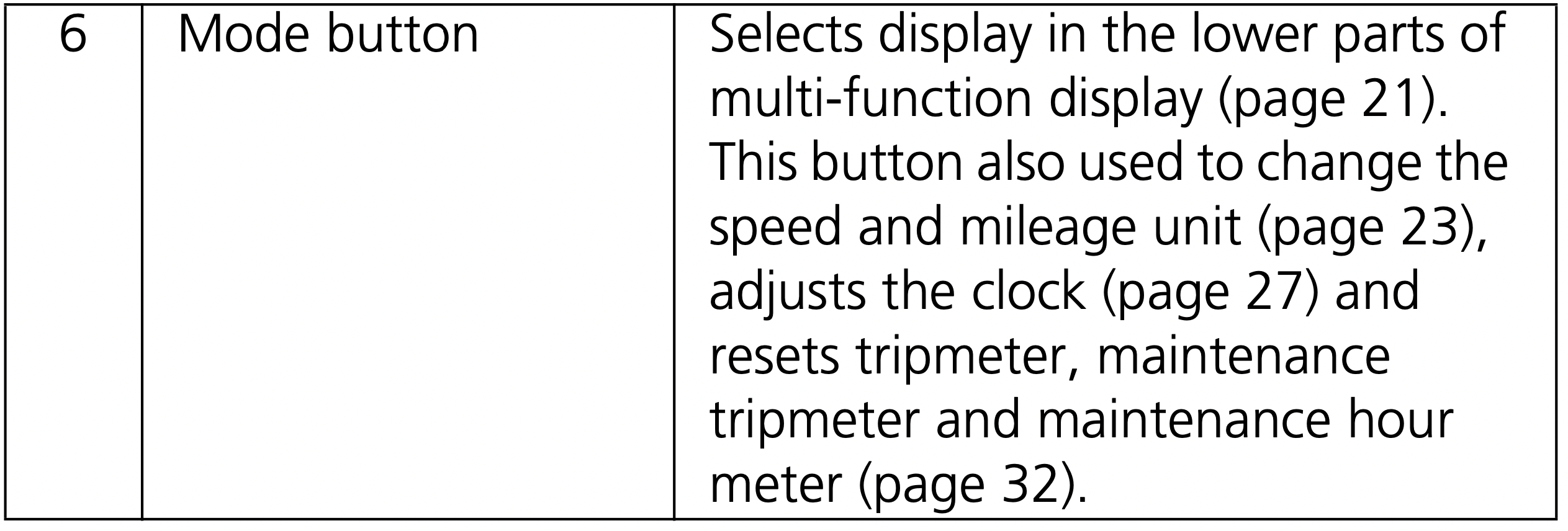
Multi-function Display
The multi-function display (1) includes the following functions:
- 4WD indicator (Except TRX420TE1)
- Gear position indicator
- Maintenance minder indicator
- Speedometer
- Fuel gauge
- Digital clock
- Odometer
- Tripmeter
- Coolant temperature gauge
- Hour meter
- Maintenance tripmeter
- Maintenance hour meter

- multi-function display
- 4WD indicator
(Except TRX420TE1) - gear position indicator
- speedometer
- maintenance minder indicator
- fuel gauge/digital clock/ odometer/tripmeter/coolant temperature gauge/hour meter/maintenance tripmeter/maintenance hour meter
Each time you press the mode button, mode will change as shown in the illustration.
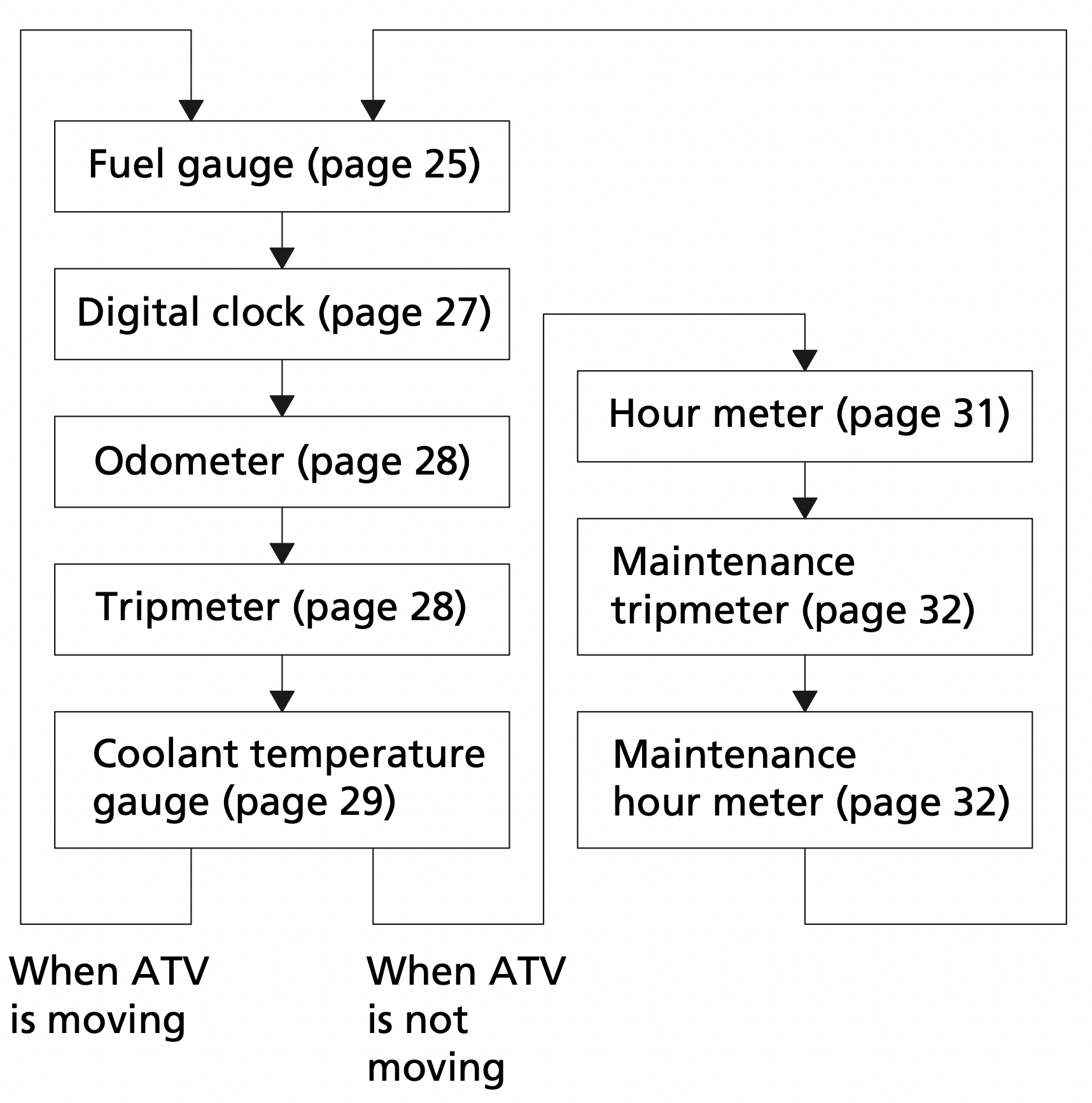
If there is a fuel warning with your ATV, the display will automatically change to the fuel gauge.
If you try to change the display back to ordinary display, it will automatically return to the fuel gauge.
If there is a coolant temperature warning with your ATV, the display will automatically change to the coolant temperature gauge. If you try to change the display back to ordinary display, it will automatically return to the coolant temperature gauge.
Speed and Mileage Unit Changing
The speedometer, odometer, tripmeter and maintenance tripmeter show in either “MPH” and “MILE” or “KM/H” and “KM”.
To change the speed and mileage unit, press and hold the mode button (1) for more than 5 seconds in odometer (page 28) with the ATV stopped.

4WD Indicator (Except TRX420TE1)
The 4WD indicator (1) appears when the 4WD mode engages (page 35).
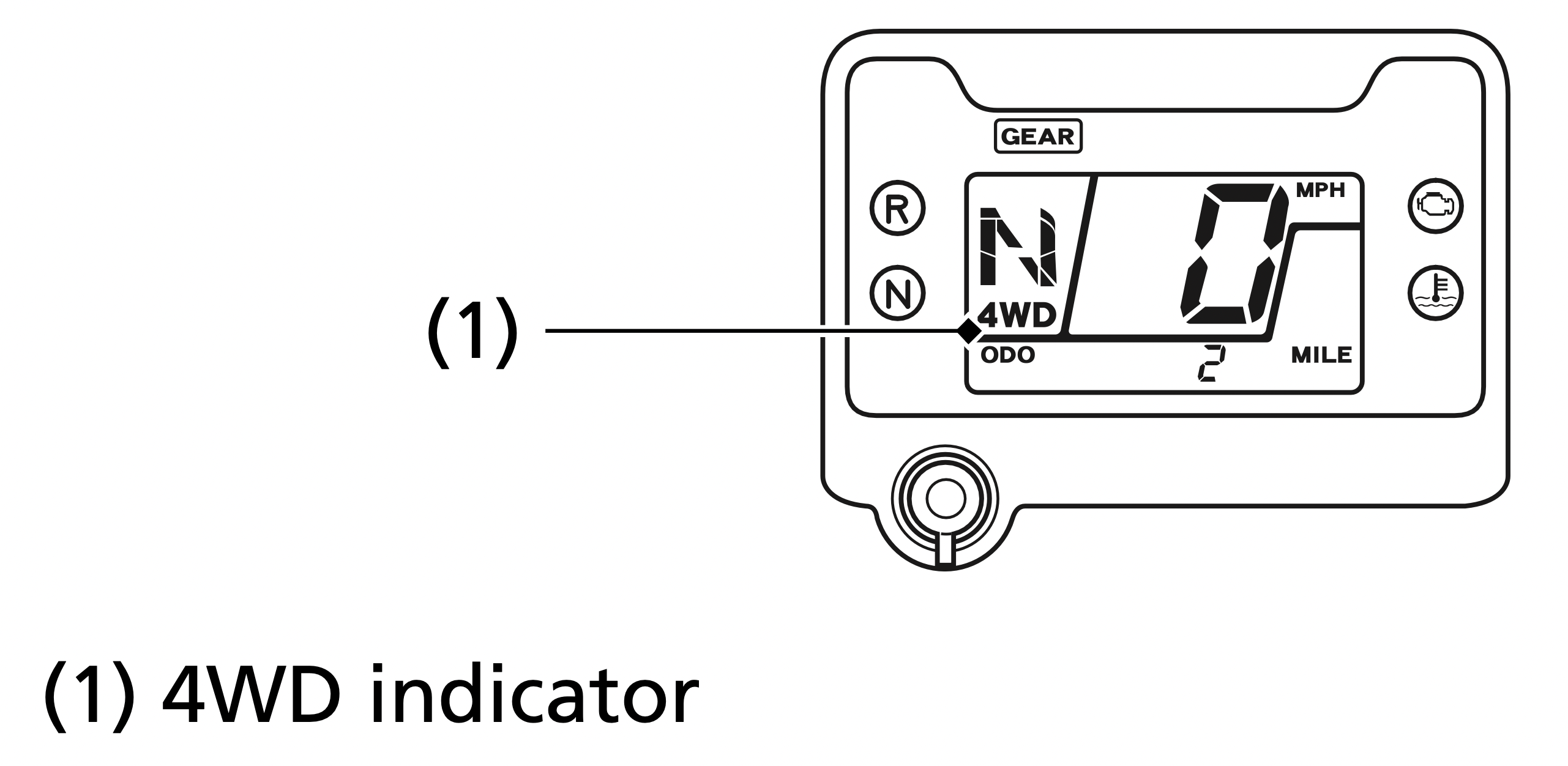
Gear Position Indicator
The gear position indicator (1) shows the gear position when the ignition switch is in the ON (q) position.
The indicator displays: N for neutral, R for reverse, and 1 – 5 for the five forward gears.
“–” will be displayed on the gear position indicator when the transmission is not shifted into gear properly. Before riding, check that the gear position is properly displayed on the gear position indicator.
If the gear position indicator shows “–” or blinks, turn the ignition switch to the OFF (w) position, and then turn it back to the ON (q) position again. If the gear position indicator shows “–”, rock the vehicle back and forth and make sure the gear position indicator is displayed properly and then if the gear position indicator still shows “–” or blinks, see your dealer.
If the “–” on the gear position indicator is blinking, see your dealer.
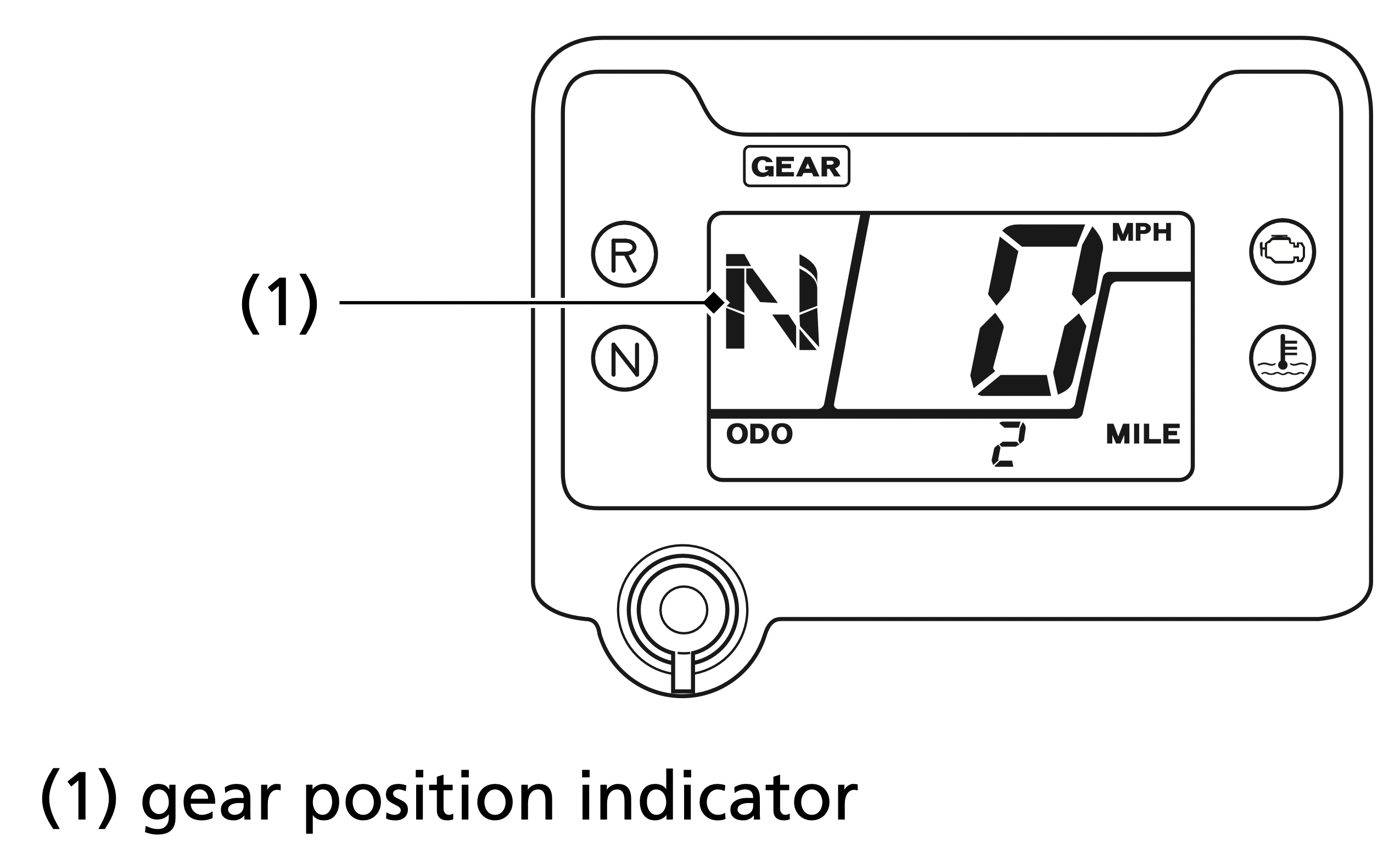
Fuel Gauge
The fuel gauge (1) shows the approximate fuel supply available with fuel mark (2). The fuel tank capacity is: 3.88 US gal (14.7 ℓ)

Regardless of what mode the display is in, when the fuel level reaches only 1st segment (3), the display will automatically switch to the fuel gauge display. You should refuel as soon as possible.
The amount of fuel remaining when there is only 1st segment is approximately: 1.82 US gal (6.9 ℓ)
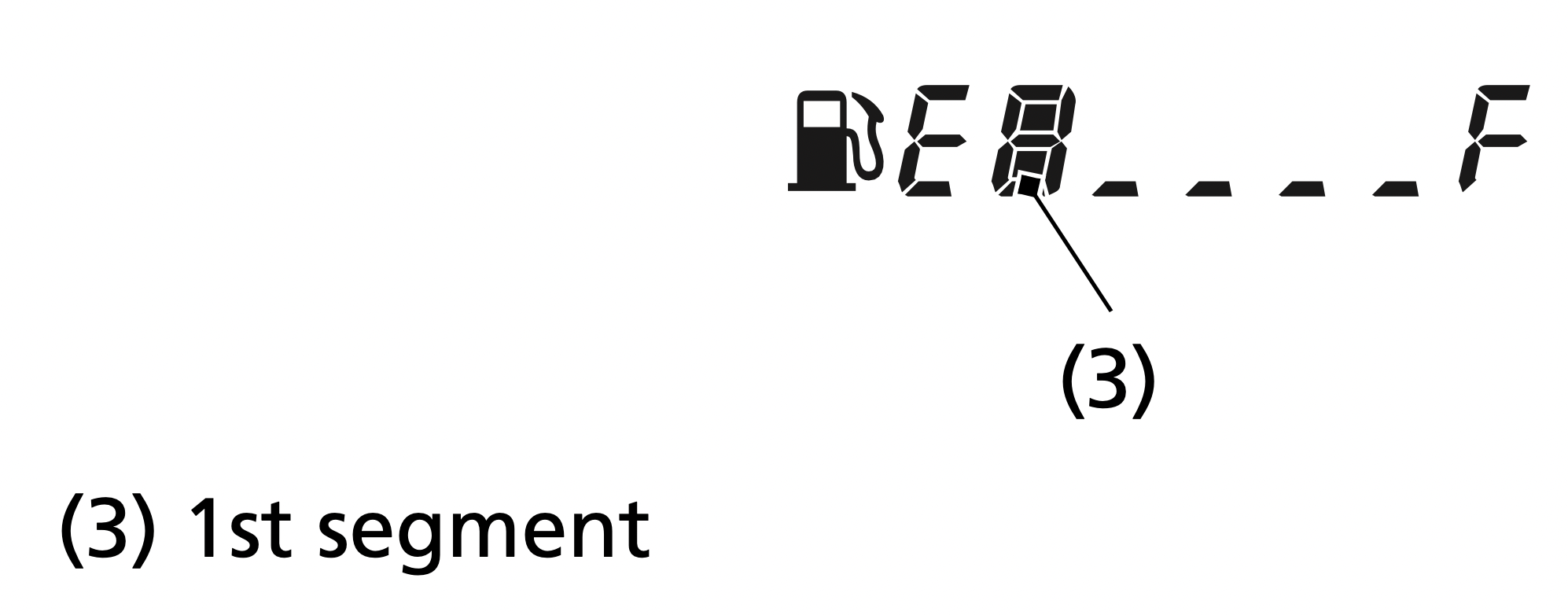
When the fuel gauge show E _ _ _ _ _ F (4) and LO FUEL (5) blink 3 times alternately and fuel mark blinks, you should refill the tank as soon as possible.
The amount of fuel reserve is approximately: 1.29 US gal (4.9 ℓ)

Fuel gauge failure:
If the fuel gauge function fails E - - - - - F (6) will blink.
See your dealer.
(The fuel mark disappears except the fuel gauge display)

Digital Clock
The digital clock (1) displays hours and minutes with the clock mark (2), when the ignition switch is ON (q).
To adjust the time, proceed as follows:
- Turn the ignition switch ON (q) to display the clock (page 21).
- Press and hold the mode button (3) until the display start blinking.
- To advance the display 1 minute at a time, press and release the mode button for 0.5 seconds.
Press and hold the mode button for more 0.5 seconds the display will begin advancing fast. - Release the mode button when the display reaches the desired time.
- To set the clock, press and release the mode button for less than 0.5 seconds.
See other models: TRX520FM1 4x4 2022 FOURTRAX FOREMAN RUBICON 2022 CRF150R 2022 CRF250RX CRF250R
The clock can be set by turning the ignition switch off and then on.
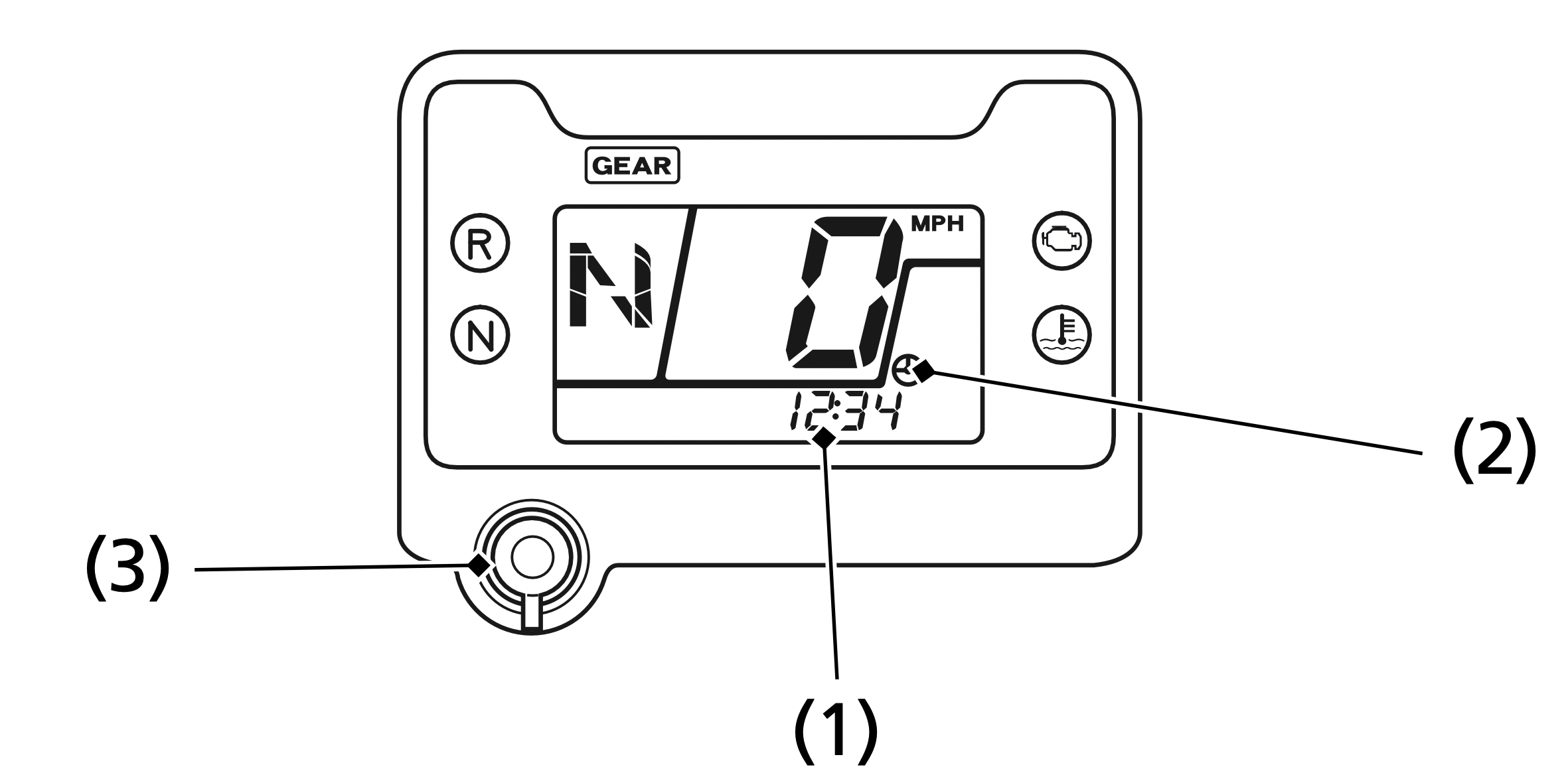
- digital clock
- clock mark
- mode button
After the battery is reconnected (page 184), check the clock. Readjust the clock if necessary.
Odometer
The odometer (1) registers total distance traveled in mileage while the ignition is ON (q) with the ODO display (2). The odometer locks at 999999 when the readout exceeds 999999.
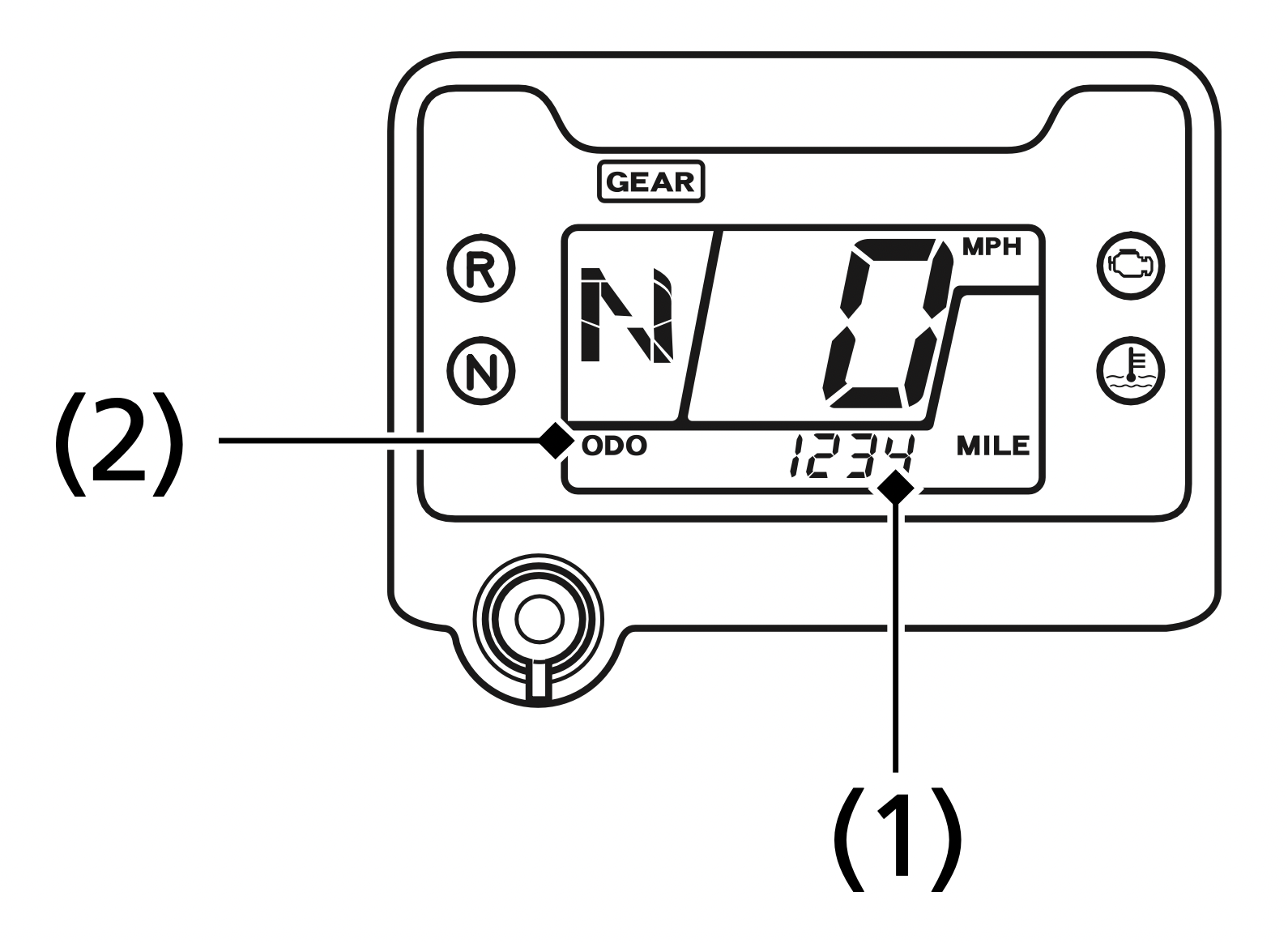
- odometer
- ODO display
Tripmeter
The tripmeter (1) shows mileage per trip with the TRIP display (2), while the ignition is ON (q) since you last reset the tripmeter. The tripmeter returns to 0.0 when the read-out exceeds 999.9. To reset the tripmeter to zero, press the mode button (3) and hold it in for at least 2 seconds in the tripmeter mode.

- tripmeter
- TRIP display
- mode button
Coolant Temperature Gauge
The coolant temperature gauge (1) with the coolant temperature mark (2) shows the coolant temperature.
When coolant temperature is low, the coolant temperature gauge will display “Lo”.
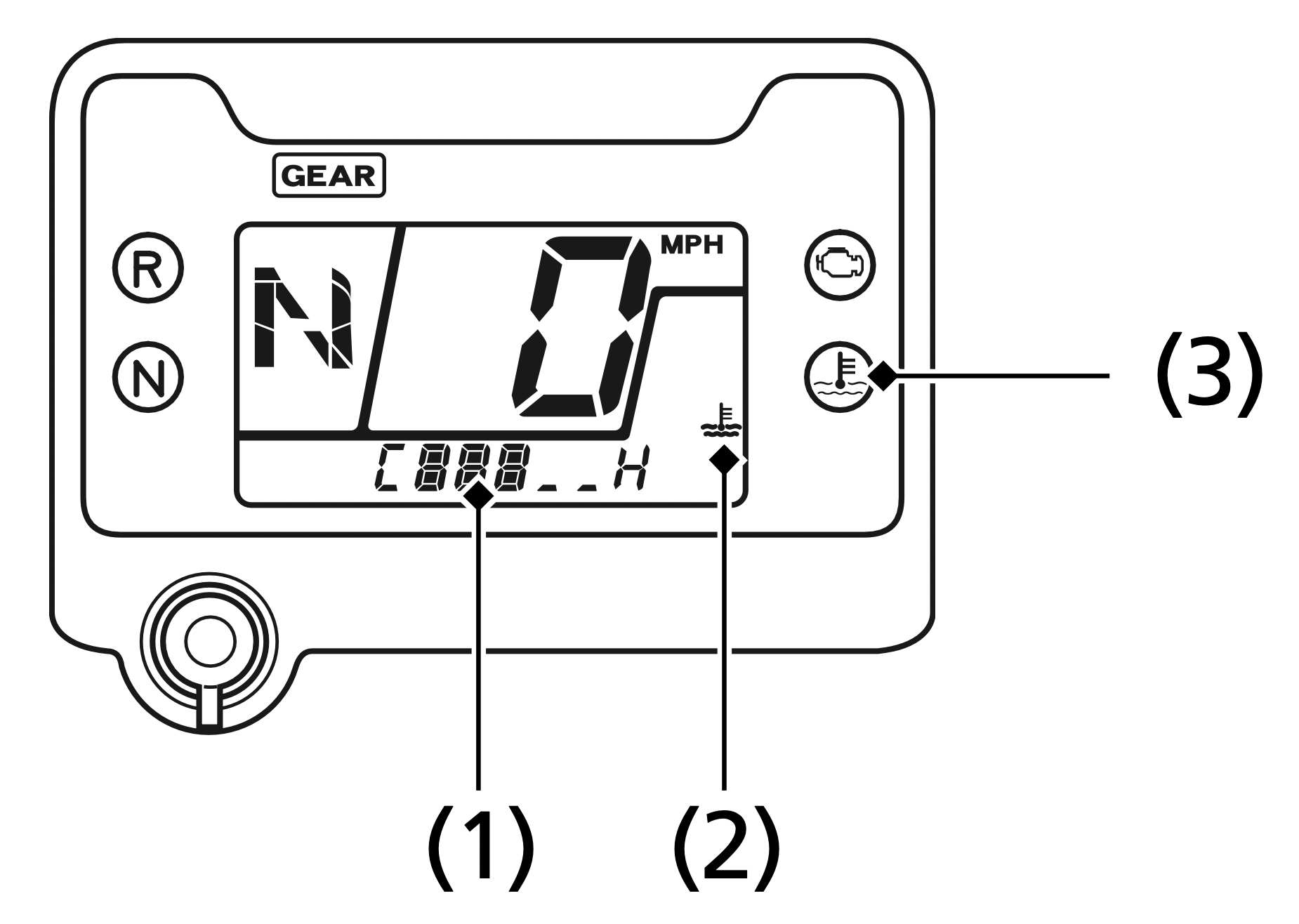
- coolant temperature gauge
- coolant temperature mark
- high coolant temperature indicator
If all sections of the coolant temperature gauge and high coolant temperature indicator are on (automatically appears in the display) while you are riding, immediately stop the vehicle, turn the engine off and check the coolant reserve tank level. See page 137.

NOTICE: Continuing to ride with an overheated engine can cause serious engine damage.
Coolant temperature gauge failure:
If the coolant temperature system has an error, the coolant temperature gauge (1) will flash and preferentially appear in the display, and/or high coolant temperature indicator (3) will turn on. If this occurs, see your dealer as soon as possible.

Hour meter
The hour meter (1) shows accumulated hours while the ignition switch is ON ( I ) with the hour meter mark (2). The hour meter provides accurate service period information for initial and regular maintenance. The hour meter locks at 99999.9 when the readout exceeds 99999.9.

- hour meter
- hour meter mark
Maintenance Tripmeter & Maintenance Hour meter
The maintenance tripmeter (1), the maintenance hour meter (2) and maintenance minder indicator (3) inform you when the mileage or operating hours on your ATV approaches and passes the maintenance interval specified on the maintenance schedule (page 106).

- maintenance tripmeter
- maintenance hour meter
- maintenance minder indicator
The maintenance tripmeter, or the maintenance hour meter and maintenance minder indicator will blink, when they reach their setting values.

Reset the meters after each scheduled maintenance.
To reset the maintenance tripmeter and the maintenance hour meter, press and hold the mode button and turn the ignition switch to ON ( I ). Continue to hold the mode button, the maintenance minder indicator will light up, and after 2 seconds will flash twice, the maintenance minder indicator is reset.
Also the maintenance tripmeter and maintenance hour meter will reset.
Maintenance Minder Indicators:

If the maintenance is done before the setting interval, be sure to reset the meters after the maintenance.
Accessories & Modifications
Modifying your ATV or using non-Honda accessories can make your ATV unsafe.
Before you consider making any modifications or adding an accessory, be sure to read the following information.
WARNING:
- Improper accessories or modifications can cause a crash in which you can be seriously hurt or killed.
- Follow all instructions in this owner’s manual regarding accessories and modifications.
Accessories
We strongly recommend that you use only Honda Accessories that have been specifically designed and tested for your ATV. Because Honda cannot test all other accessories, you must be personally responsible for proper selection, installation, and use of non-Honda accessories.
Check with your dealer for assistance and always follow these guidelines:
- Make sure the accessory does not obscure any lights, reduce ground clearance, limit suspension travel or steering travel, or interfere with operating any controls.
- Make sure the accessory does not interfere with your ability to shift body position on the seat or operate hand and foot controls.
- Do not add any electrical equipment that will exceed the vehicle’s electrical system capacity (page 231). A blown fuse can cause a loss of lights or engine power (page 216).
Modifications
We strongly advise you not to remove any original equipment or modify your ATV in any way that would change its design or operation. Such changes could seriously impair your ATV’s handling, stability, and braking, making it unsafe to ride.
We also advise you not to make any modifications or remove any equipment (such as the USDA qualified spark arrester or emission control system components) that would make your ATV illegal in your area.
Removing or modifying your lights, exhaust system, emission control system, or other equipment can also make your ATV illegal.
Starting & Stopping the Engine
Always follow the proper starting procedure described below.
For your safety, avoid starting or operating the engine in an enclosed area such as a garage. Your ATV’s exhaust contains poisonous carbon monoxide gas which can collect rapidly in an enclosed area and cause illness or death.
WARNING:
- Running the engine of your vehicle while in an enclosed or even partially enclosed area can cause a rapid build-up of toxic carbon monoxide gas.
- Breathing this colorless, odorless gas can quickly unconsciousness and lead to death.
- Only run the vehicle’s engine when it is located in a well ventilated area outdoors.
Preparation
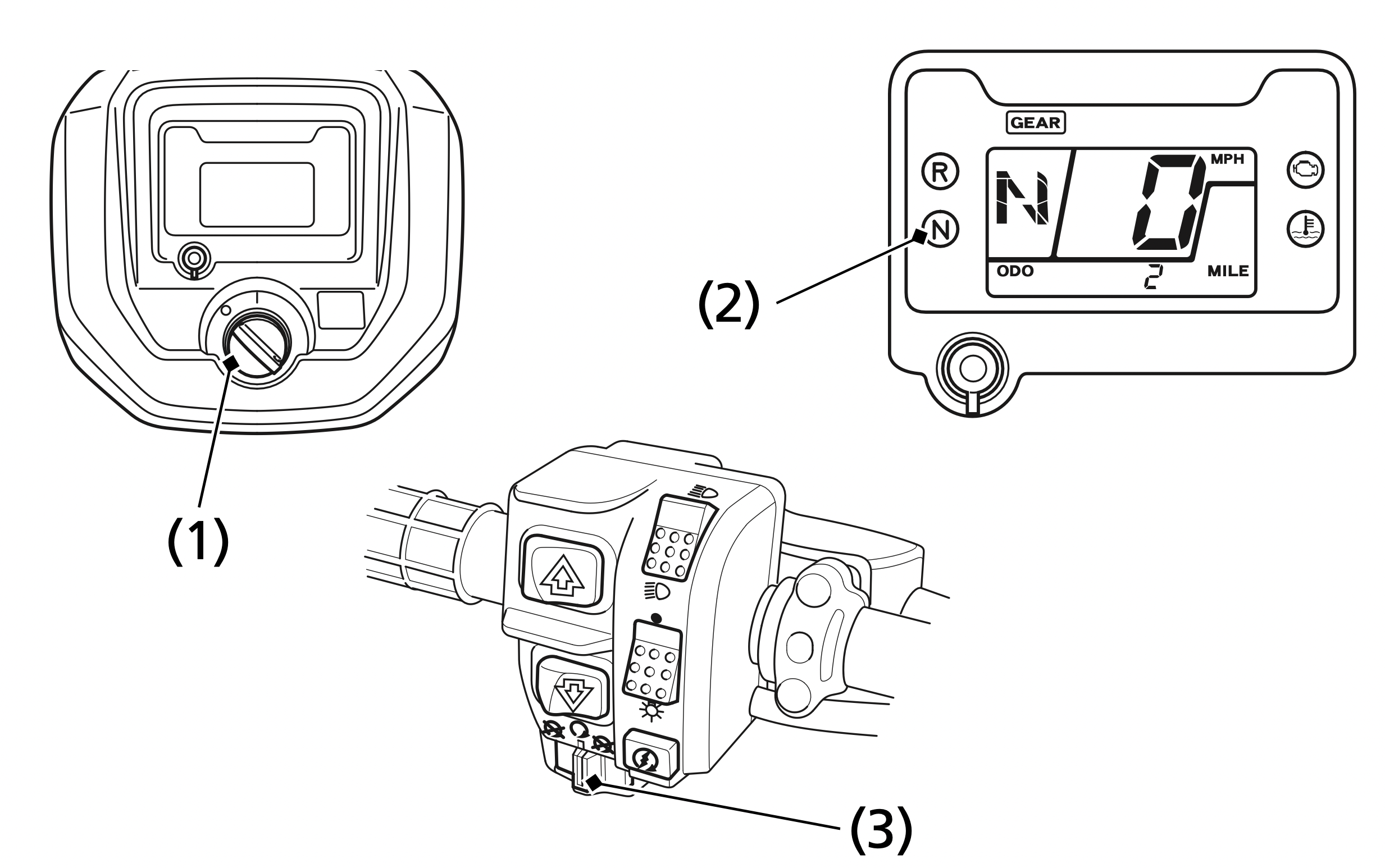
- Before starting, select a level surface and lock the parking brake (page 42).
- Turn the ignition switch (1) to ON ( I ).
Confirm the following:
- The transmission is in neutral, and the neutral indicator (2) is ON and the gear position indicator shows “N”.
- The engine stop switch (3) is set to RUN (
 ).
).
Starting Procedure
This ATV is fuel-injected with an automatic choke. Follow the procedure indicated below.
Any Air Temperature
- Press the start button with the throttle completely closed.
The engine will not start if the throttle is fully open (because the electronic control module cuts off the fuel supply).
Snapping the throttle or fast idling for more than 5 minutes may cause exhaust pipe and muffler discolorations.
Flooded Engine
If the engine fails to start after repeated attempts, it may be flooded with excess fuel. To clear a flooded engine:
- Leave the engine stop switch set to RUN (
 ).
). - Open the throttle fully.
- Press the start button for 5 seconds.
- Follow the normal starting procedure.
- If the engine starts, then open the throttle slightly if idling is unstable.
If the engine does not start, wait 10 seconds, then follow steps 1 – 4 again.
If the engine still won’t start, refer to If Your Engine Quits or Won’t Start, page 204.
Bank Angle Sensor Ignition Cut-off System
Your vehicle’s banking (lean angle) sensor system is designed to automatically stop the engine if the vehicle is overturned.
Before restarting the engine, you must turn the ignition switch to the OFF ( O ) position and then back to ON ( I ). The engine will not restart until you perform this procedure.
Stalled Engine
You can restart the engine while the vehicle is stopped by squeezing the front brake lever and pressing the start button.
Do not press the throttle lever while starting in gear. The engine will not start if the throttle is fully open (because the electronic control module cuts off the fuel supply).
Once you have started the engine, release the front brake lever, then apply throttle gradually.
How to Stop the Engine
Normal Engine Stop
To stop the engine, make sure the transmission is in neutral by checking that the neutral indicator light is on, then turn the ignition switch to OFF ( O ).
The engine stop switch should normally remain in the RUN (  ) position even when the engine is OFF.
) position even when the engine is OFF.
If your ATV is stopped with the engine stop switch OFF (  ) and the ignition switch ON ( I ), the battery will discharge.
) and the ignition switch ON ( I ), the battery will discharge.
Emergency Engine Stop
To stop the engine in an emergency, use the engine stop switch. To operate, slide the switch to either OFF (  ) position.
) position.
Taking Care of the Unexpected
General Guidelines
Keeping your ATV well-maintained is the best way to reduce the possibility of having a problem while riding. However, problems can arise even with well-maintained machines.
Remember to take along your owner’s manual, the tool kit that came with your ATV, and any other items (such as tire repair supplies and additional tools) that might help you solve a problem on your own.
If something goes wrong during a ride, the first thing to do is stop as soon as you safely can. Do not continue riding if you have a flat tire, or you hear an unusual noise, or your ATV just doesn’t feel right. If you continue riding, you could cause more damage and endanger your own safety.
After stopping, take time to assess the situation. Carefully inspect your ATV to identify the problem, then consider your options before you decide what to do.
If a problem is relatively minor and you have the tools, supplies, and skills to make a permanent repair, you may be able to fix it on the trail and continue riding. Or, you may be able to make a temporary repair that allows you to slowly ride back to your base where you can make a permanent repair or get help.
When a problem is more serious — or you don’t have the tools, supplies, experience, or time to deal with it — you need to choose the safest way to get yourself and your ATV back to base. For example, if you are close enough, you (or you and another person) might be able to push it back.
Should you ever have a problem while riding, please follow these guidelines:
- Always put personal safety first.
- Take time to assess the situation and your options before deciding what to do.
- If the problem is relatively minor and you have the tools, supplies, and skills to make a temporary repair, be sure to have permanent repairs made as soon as possible.
- Do not continue riding if you are hurt or your ATV is not in safe riding condition.
Additional recommendations for specific problems follow.
If Your Engine Quits or Won’t Start
Proper operation and maintenance can prevent starting and engine performance problems. In many cases, the cause of the problem may be a simple operational oversight.
If you have a problem starting the engine — or experience poor engine performance — the following information may help you. If you can’t correct the problem, see your dealer.
If your ATV won’t start, listen as you press the start button. If you don’t hear the starter motor turning, refer to the Starter motor doesn’t operate symptom. If you can hear the starter motor working normally, refer to the Starter motor works, but the engine won’t start symptom.
|
SYMPTOM: Starter motor doesn’t operate. |
|
|
POSSIBLE CAUSE |
WHAT TO DO |
|
ignition switch OFF |
Turn the ignition switch ON. |
|
engine stop switch OFF |
Slide the engine stop switch to RUN. |
|
transmission not in neutral |
Shift into neutral. |
|
blown fuse |
Replace with a new fuse of the same rating (page 216). |
|
battery lead loose |
Tighten the battery lead. |
|
low (or dead) battery |
Charge the battery (page 186). If charging doesn’t help, see your dealer. |
|
faulty starter motor |
If all possible causes are negative, the starter motor may be faulty. See your dealer. |
|
SYMPTOM: Starter motor works, but the engine won’t start. |
|
|
out of fuel |
Fill the fuel tank. |
|
flooded engine |
See Flooded Engine (page 75). |
|
loose or unconnected spark plug cap |
Install the spark plug cap securely. If the engine still won’t start, see your dealer. |
|
loose battery cables |
Tighten the battery terminal bolts. |
|
weak battery |
Charge the battery (page 186). If charging doesn’t help, see your dealer. |
|
SYMPTOM: Engine starts, but runs poorly. |
|
|
high coolant temperature |
Check the coolant temperature gauge and high coolant temperature indicator. Refer to If the High Coolant Temperature Indicator Lights, page 214. |
|
runs erratically, misfires |
See your dealer. |
|
blubbers (rich fuel mixture) |
See your dealer. |
|
sooty exhaust (rich fuel mixture) |
See your dealer. |
|
detonates or pings under load |
If applicable, switch to the recommended octane gasoline (page 119) or change your brand of gasoline. If the problem persists, see your dealer. |
|
afterfires (backfires) |
See your dealer. |
|
pre-ignition (runs on after ignition switched OFF) |
See your dealer. |
|
SYMPTOM: Engine starts, but runs poorly or dies when hot. |
|
|
poor or inadequate fuel flow due to clogged fuel filter |
See your dealer. |
If the Shift Switches Do Not Function
If one or both shift switches do not function, see the following instructions. If proper function cannot be restored, see your dealer.
When the engine is running:
- Stop the ATV.
- Turn the ignition switch to the “OFF” (O) position.
- After the engine stops, turn the ignition switch to the “ON” (I) position.
- Press both shift switches and check that they are functioning.
- If both switches are functioning, shift into neutral and restart the engine.
If one or both switches are not functioning, see Emergency Gear Selection & Operation, page 208.
When the engine is stopped and the ignition switch is “ON” ( I ):
- Turn the ignition switch to the “OFF” (O) position.
- Turn the ignition switch to the “ON” (I) position.
- Press both shift switches and check that they are functioning.
- If both switches are functioning, shift into neutral and restart the engine.
If one or both switches are not functioning, see Emergency Gear Selection & Operation, page 208.
When the battery is low (or dead):
- See If the Battery Is Low (or Dead), page 222.
Emergency Gear Selection & Operation
If the shift switches do not operate, use the following procedure to manually select a gear so you may drive the vehicle to a location where it can be loaded and transported to your dealer.
- Turn the ignition switch to the “ON” (I) position.
- Remove the seat (page 114).
- Remove the rear fender cover (page 117) and tank cover assembly (page 115).
- Remove the gear change tool from under the rear fender cover (page 112).
- Check the neutral indicator.
If the transmission is in neutral, go to step 6.
If the transmission is not in neutral, use the gear change tool to shift to neutral so you will be able to start the engine. Refer to How to Shift Gears Manually: (page 209). - Apply the parking brake.
- Press the start button to start the engine.
- Select the gear you want. For running on level ground: use 3rd or 4th gear. For mountainous roads: use 2nd or 3rd gear. Refer to How to Shift Gears Manually: (page 209).
- Return the gear change tool to under the rear fender cover.
- Install the tank cover assembly and rear fender cover.
- Install the seat.
- Get on the ATV. Ride it at a safe speed to a place where it can be repaired or serviced.
How to Shift Gears Manually:
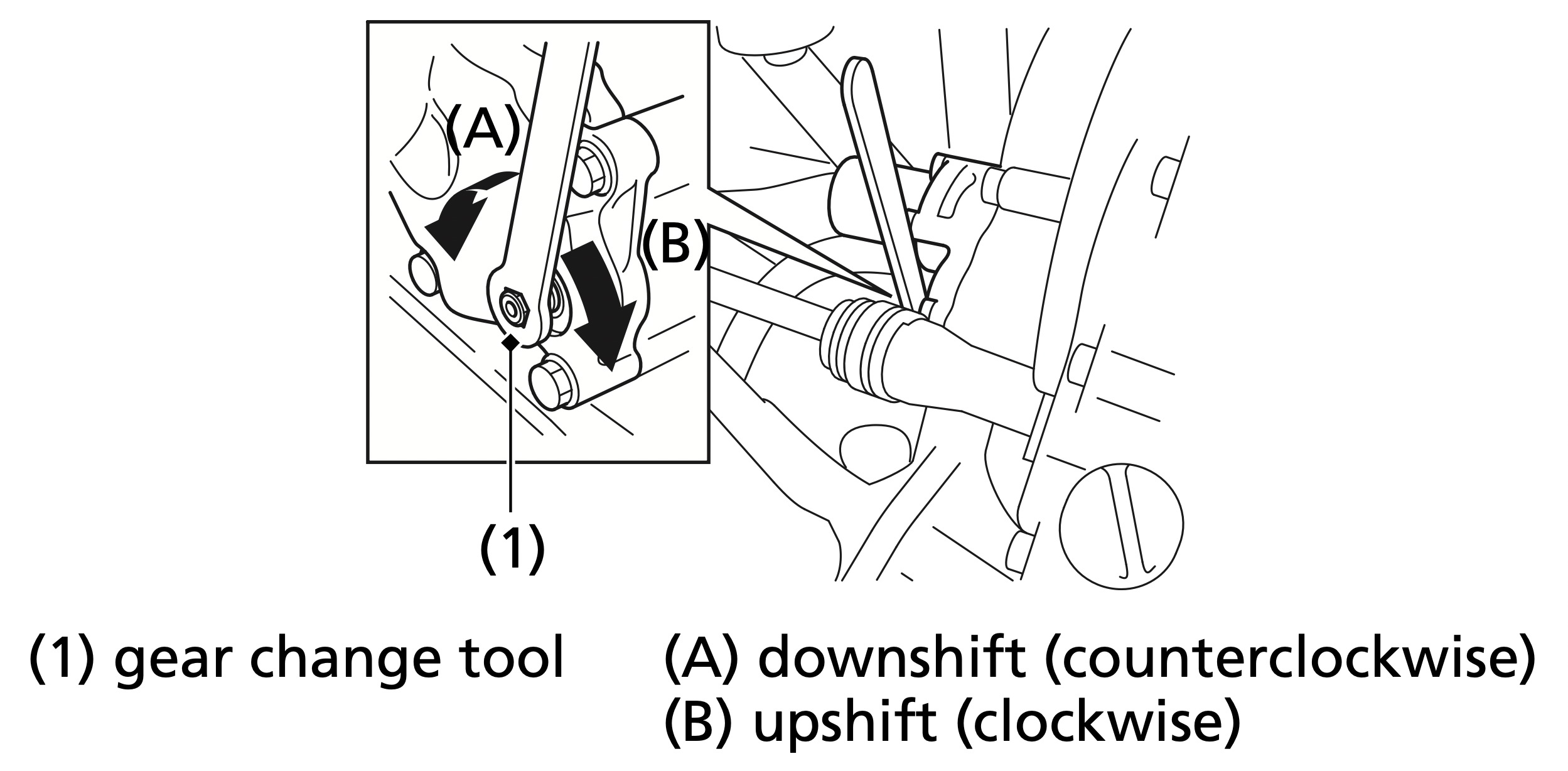
- With the ATV unoccupied, align the hexagonal hole of the gear change tool (1) with the hexagonal end of the secondary spindle which is located on the front crankcase.
- To downshift, turn the gear change tool to direction (A).
To upshift, turn the gear change tool to direction (B). - If the alignment of the hexagonal hole does not allow sufficient movement in the desired shifting direction, remove the tool, flip tool over, and realign the hexagonal hole with the secondary spindle.
- If the transmission does not shift, rock the vehicle back and forth and try again.
- Return the gear change tool to under the rear fender cover.
Do not attempt to shift gears manually using the gear change tool while riding.
If the transmission is shifted manually when the electric shift system is functioning, the system will shutdown automatically and the shift switches will not operate. To reactivate the system, turn the ignition switch to the “OFF” (O) position, then turn it back to the “ON” (I) position.
If You Have a Flat Tire
How you handle a flat tire on the trail depends on how serious the tire damage is, and what tools and supplies you have with you.
If you have a slow leak or a minor puncture, use the plug method to make a temporary repair. (The plug method is applied from the outside of the tire and is the same as that for conventional tubeless tires.)
A plug-type repair kit, available at most auto parts stores or service stations, provides a plug, an installation tool, tire cement, and an instruction sheet. Follow the instructions provided with the repair kit to make a temporary repair.
As soon as possible, have the tire permanently repaired by your dealer. Any tire that cannot be repaired should be replaced.
Whenever the ATV is to be operated far from service facilities or available transportation, we recommend that you carry a tire pump and a repair kit with the vehicle.
If the leak is more serious, or a temporary repair doesn’t hold, the tire must be replaced. The tire will also need to be replaced if it is damaged (page 177). Replacing a tire involves removing and reinstalling the wheel (page 212).
If you are unable to repair a flat tire on the trail, you will need to send for help. We strongly recommend that you do not try to ride with a flat tire. The ATV will be hard to handle, and if the tire comes off the rim, it may lock up the wheel and cause you to crash.
WARNING:
- Riding your ATV with a temporary tire repair can be risky.
- If the temporary repair fails, you can crash and be seriously injured or killed. If you must ride with a temporary tire repair, ride slowly and carefully until the tire is permanently repaired or replaced.
Emergency Wheel Removal/Installation
Refer to Safety Precautions on page 103.
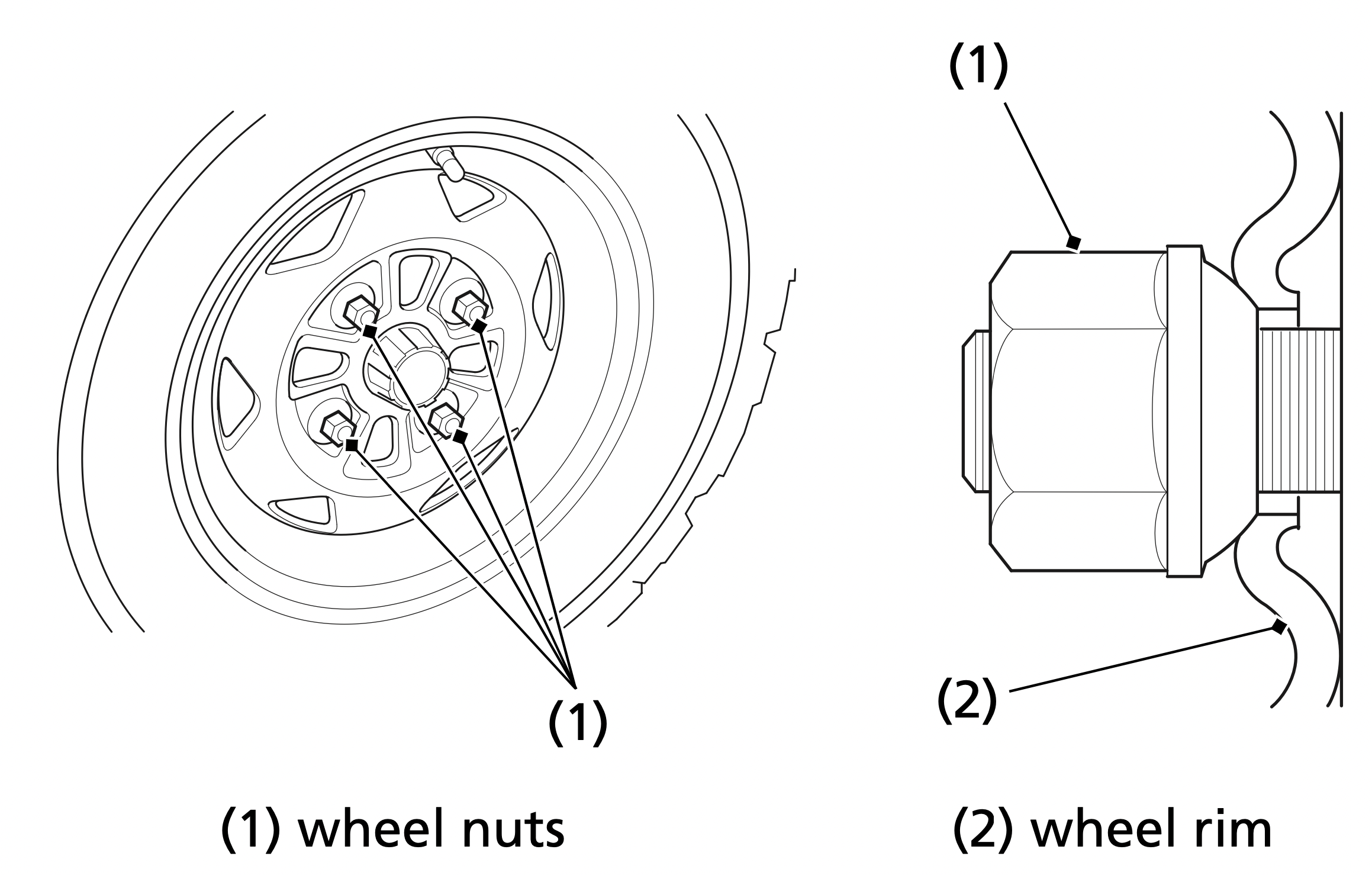
Removal
- Park your ATV on a firm, level surface.
- Loosen — but do not remove — the wheel nuts (1).
- Raise the front (or rear) wheels off the ground and place a support block under the vehicle.
- Remove the wheel nuts.
- Remove the wheel.
Avoid getting grease, oil, or dirt on the front brake disc or pad surfaces when removing and installing each wheel. Any contamination can cause poor brake performance or rapid pad wear after reassembly.
Installation
- Position the wheel.
- Position the wheel nuts so that the tapered sides face the wheel rim (2).
- Hand-tighten the wheel nuts on the wheel, then lower the ATV to the ground before tightening the nuts in a crisscross (rather than circular) pattern to the specified torque: 47 lbf·ft (64 N·m , 6.5 kgf·m)
If a torque wrench was not used for installation, see your dealer as soon as possible to verify proper assembly. Improper assembly may lead to loss of braking capability.
If the High Coolant Temperature Indicator Lights
Normally, the high coolant temperature indicator will only light momentarily when you turn the ignition to ON (I).
High coolant temperature may be caused by restriction of air flow to the radiator (such as mud caked on the radiator), extended idling, an oil leak, a coolant leak, a low oil level, a low coolant level, or extended operation under adverse conditions.
If the all segment of the coolant temperature gauge and high coolant temperature indicator are on while you’re riding, don’t ignore it. Pull safely to a stop. Stop the engine as soon as it’s safe to do so, and let it cool.
NOTICE
Continuing to ride with high coolant temperature or an overheated engine can cause serious engine damage.
- A steaming engine indicates a coolant leak. Shut the engine off and wait until the steaming stops. Look for a leak, but don’t touch the engine or radiator system. Let everything cool off first.
- Check for any restriction of air flow to the radiator.
- If there’s no obvious problem, leave the engine on so the fan and coolant circulating system can continue working. Monitor the coolant temperature gauge and high coolant temperature indicator. The indicator may turn off after a brief stop with no load on the engine.
- Check the radiator fan.
If the fan is not working, turn the engine off. Open the fuse box (page 217) and check the radiator fan fuse. If the fuse is blown, replace it with the proper (same rating) spare fuse. Start the engine. If the all segment of the coolant temperature gauge and high coolant temperature indicator stays on, turn the engine off. If the radiator fan is working, visually check the coolant level in the reserve tank, located under the left front fender. It isn’t necessary to touch the radiator system. - If the reserve tank is low or empty, don’t ride without adding coolant (page 137). After adding coolant, turn the engine on and check the coolant temperature gauge and high coolant temperature indicator.
If the indicator doesn’t turn off, do not ride. The engine needs repair.
Transport your ATV to your dealer (page 194).
If the temperature drops to normal, check the coolant level. If it has gone down, add more coolant. - Check for an oil leak.
- Check the oil level. If necessary, add the recommended oil (page 125) to the upper level mark. If you must leave your ATV to get oil, secure it as much as possible.
- Start the engine, and check that the coolant temperature gauge and high coolant temperature indicator goes off.
If you are able to resume riding, continue to monitor the coolant temperature gauge and high coolant temperature indicator frequently.
If there is an oil leak — do not ride the ATV until the leak is repaired by your dealer (page 194).
If there’s a mild coolant leak, you can ride for awhile, carefully watching the coolant temperature gauge and indicator. Be prepared to stop and add more coolant or water. If the leak is bad, transport your ATV to your dealer (page 194).
If a Fuse Blows
All of the electrical circuits on your ATV have fuses to protect them from damage caused by excess current flow (short circuit or overload).
If something electrical on your ATV stops working, the first thing you should check for is a blown fuse (1).
Check all the fuses before looking elsewhere for another possible cause of the problem. Replace any blown fuses and check component operation.

The main fuse and the circuit fuses are located under the rear fender cover.
Recommended Fuses

Main and Shift Motor Fuses Access
- To prevent an accidental short circuit, turn the ignition switch to OFF (O) before checking or replacing the fuses.
- Remove the seat (page 114).
- Remove the rear fender cover (page 138).
- To access the main fuses (2) (3) and shift motor fuse (4), remove the fuse box cover (5).
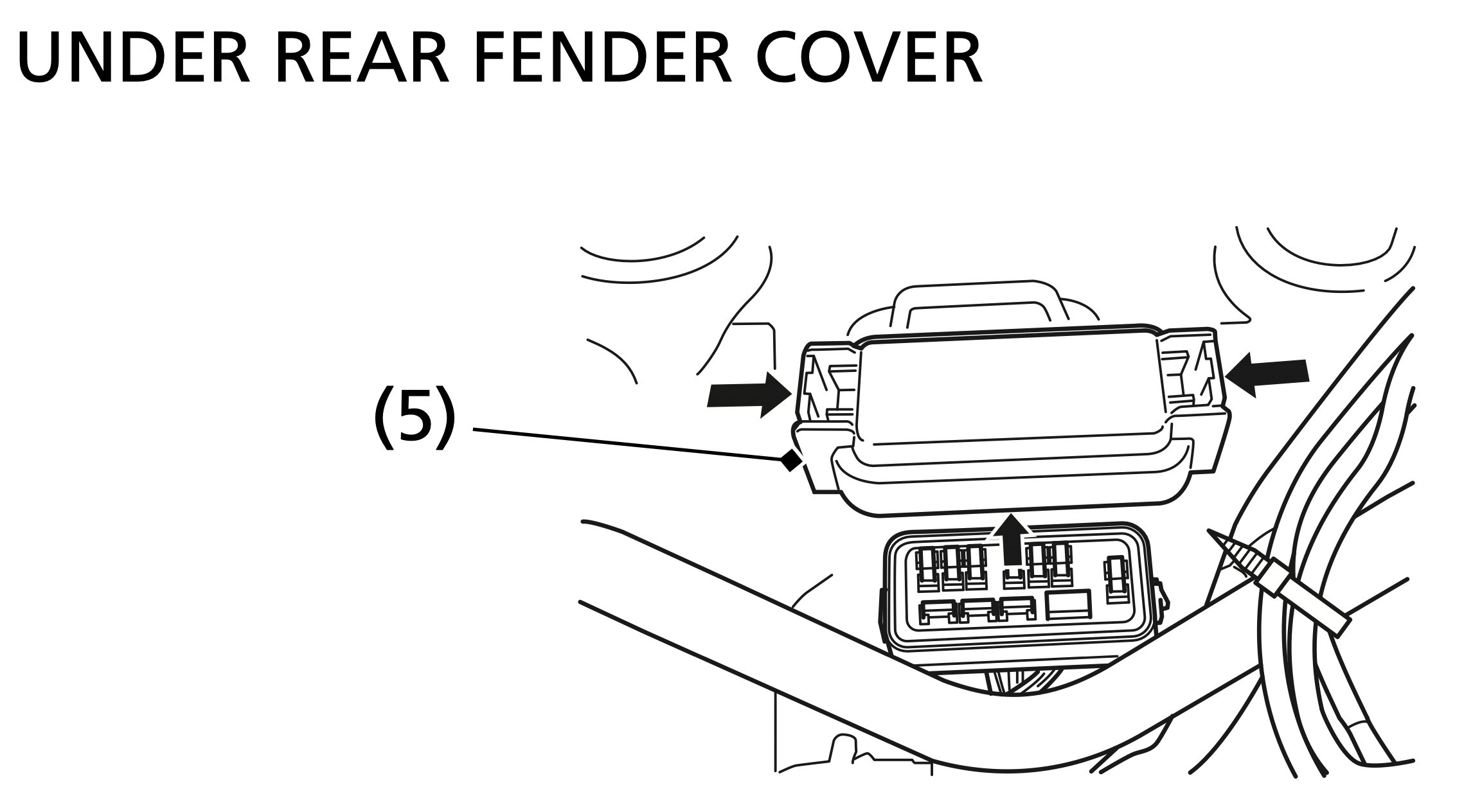

- Pull the main fuse out with the fuse puller on the underside of the rear fender cover (page 113).
If it is blown, install the spare fuses (6).
Circuit Fuses Access
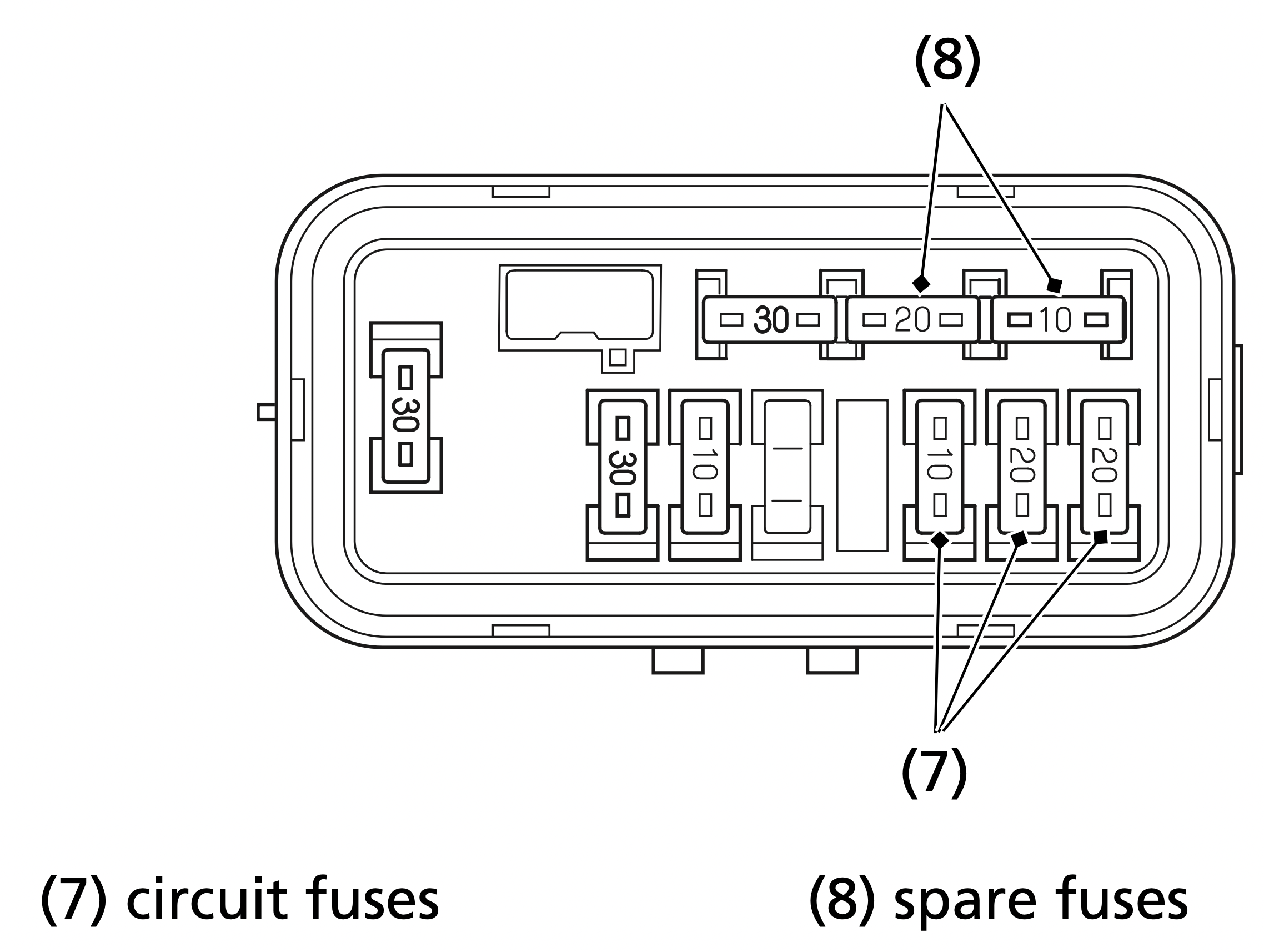
- To check or replace a circuit fuse (7), pull the old fuse out of its retaining clips with fuse puller on the underside of the rear fender cover (page 113).
If the fuse is blown, replace it with a spare fuse (8) of the same rating.
If you do not have a replacement fuse with the proper rating for the circuit, install one with a lower rating.
NOTICE: Replacing a fuse with one that has a higher rating greatly increases the chance of damage to the electrical system. - Install the fuse box cover.
- Install the rear fender cover.
- Install the seat.
If you do not have a spare fuse and you cannot ride the ATV without fixing the problem, take a fuse of the same rating or a lower rating from one of the other circuits that you can do without temporarily.
If you replace a blown fuse with a spare fuse that has a lower rating, replace the fuse with the correct rating as soon as you can. Also remember to replace any spare fuses that were installed.
If the replacement fuse of the same rating burns out in a short time, there is probably a serious electrical problem on your ATV. Leave the blown fuse in that circuit and have your ATV checked by your dealer.
If You Crash
Personal safety is your first priority after a crash. If you or anyone else has been injured, take time to assess the severity of the injuries and whether it is safe to continue riding. If you cannot ride safely, send someone for help. Do not ride if you will risk further injury.
If you decide you are capable of riding safely, carefully inspect your ATV for damage and determine if it is safe to ride. Check the tightness of critical nuts and bolts securing such parts as the handlebar, control levers, brakes, and wheels.
If there is minor damage, or you are unsure about possible damage but decide to try riding the ATV back to your base, ride slowly and cautiously.
Sometimes, crash damage is hidden or not immediately apparent. When you get home, thoroughly check your ATV and correct any problems you find. Also, be sure to have your dealer check the frame and suspension after any serious crash.
If You Lose Your Key
Be sure to record your key number (1). Store the spare key and recorded key number in a safe location. You’ll need this number to have a duplicate key made.
If you lose your key and aren’t carrying a duplicate, either get your spare or have one made. If you don’t know your key number, call the dealer where you purchased your Honda ATV. They may have it listed in their records. If they don’t, transport your ATV to them or the nearest dealer. The dealer will probably have to remove the ignition switch assembly to find the key number so they can make a key for you.
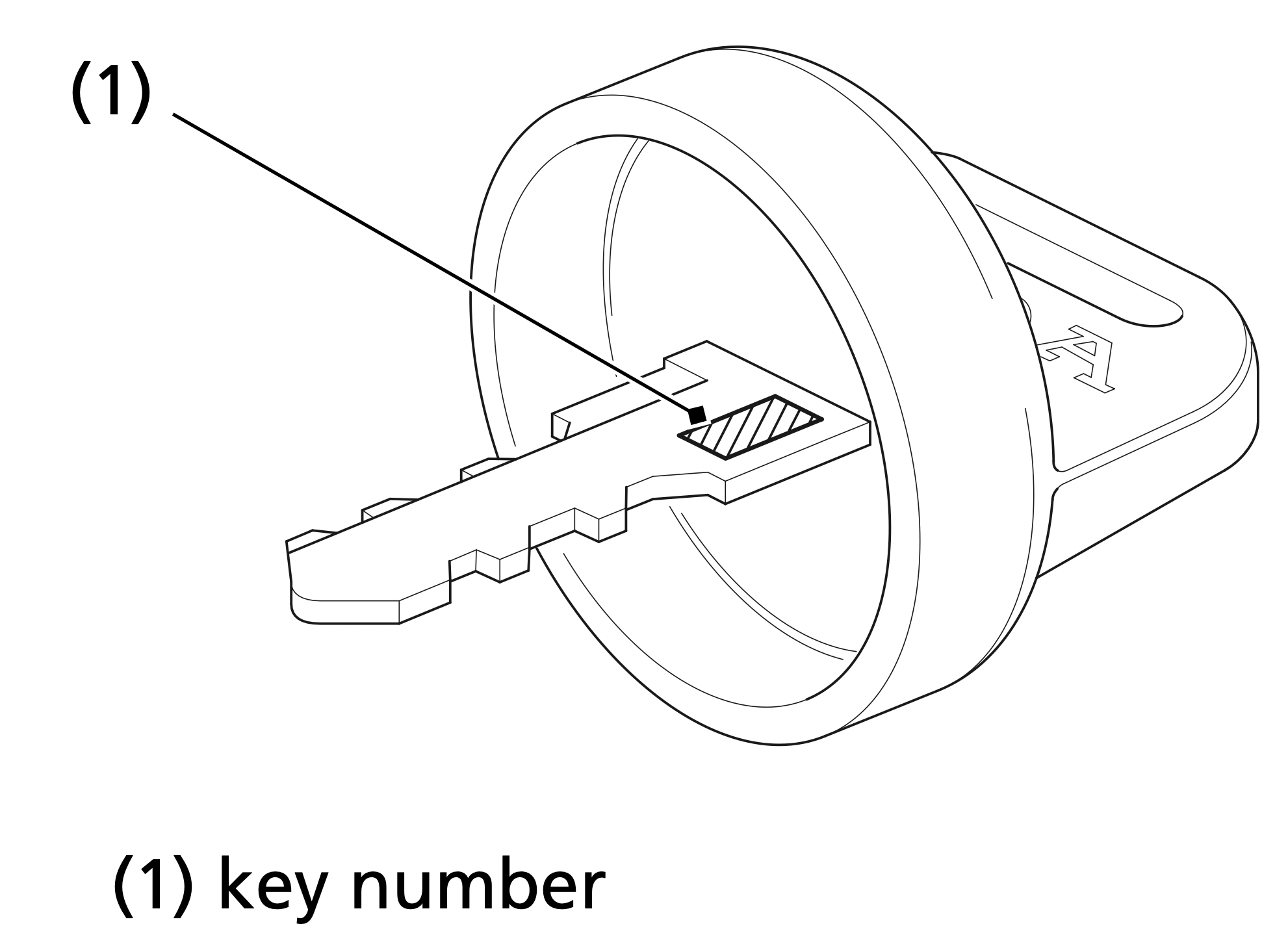
If the Battery Is Low (or Dead)
Jump starting is not recommended, especially if you use an automobile battery. The greater amperage of an automobile battery when the car engine is running can damage your ATV’s electrical system.
Bump starting is also not recommended.
If you can’t charge the battery or it appears unable to hold a charge, contact your dealer.
If a Component Fails
The brake levers or pedal, control cables, and other components can be damaged as you ride in dense brush or over rocky terrain. Making a trailside repair depends on how serious the damage is and what tools and supplies you have with you.
- If any component of the brake system is damaged, you may be able to ride carefully back to your base using the other brake components for slowing or stopping.
- If you damage a throttle cable or other critical component, your ATV may be unsafe to ride. Carefully assess the damage and make any repairs that you can. But if there is any doubt, it’s best to be conservative and safe.
